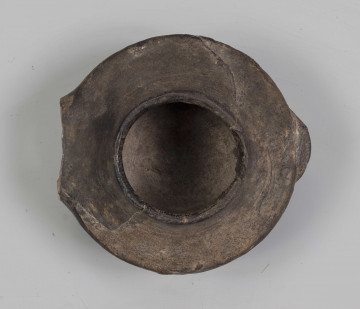
Oil lamp
50 — 100
National Museum in Lublin
Part of the collection: Set of archaeological relics found in the Lublin Region
Olive lamps were used in many civilizations of the ancient world: in Egypt, Mesopotamia, Greece and Rome. In the barbarian world they were imports.
It is not known where the four clay olive lamps inventoried in the collection of the National Museum in Lublin come from. They are probably relics from collections dating from before World War II. Inventory cards of many relics from that period note that they come from the former Jesuit Collegium Bobolanum, now the Military Hospital on Racławickie Avenue in Lublin.
Antique lamps consist of an oil container and a wick, for the manufacture of which moss, later plant fibres, were used.
One of the lamps is a miniature Roman lamp imitating a bronze item. It was made of beige-greenish clay without slipware. It is round, with a short burner. The receptacle is cracked, with a small disk, slightly recessed, and with wide arms covered with granules all over. The central olive hole is asymmetrical. There are vice marks on the disk, and the foot is flat.
Lamps of this type were produced in Rome, Carthage, central and northern Italy, and in Recia and Pannonia from the 2nd half of the 2nd to the 5th century AD. They were the main source of lighting of this era. They were produced on a mass scale, usually from fired clay and using casts.
Author / creator
Dimensions
cały obiekt: height: 9 cm, width:
Object type
tool
Technique
firing
Material
clay
Creation time / dating
Creation / finding place
Owner
The National Museum in Lublin
Identification number
Location / status

50 — 100
National Museum in Lublin

250 — 300
National Museum in Lublin

201 — 500
National Museum in Lublin
DISCOVER this TOPIC
Castle Museum in Łańcut
DISCOVER this PATH
Educational path